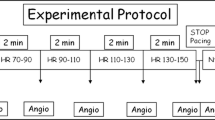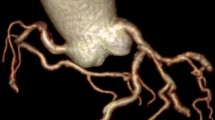Abstract
Background
Coronary artery tortuosity (CAT) is a relatively common finding on coronary angiography and may be associated with impaired left ventricular relaxation and coronary ischemia However, the significance of CAT remains unknown. This study aimed to investigate whether the severity of tortuosity in the targeted coronary segment is a predictor of stent restenosis.
Methods
The study included a total of 637 patients undergoing drug-eluting stent implantation due to stable or unstable angina and who had no native coronary artery stenosis on their last coronary angiogram. The patients were separated into two groups: 312 patients with in-stent restenosis and 325 patients without in-stent restenosis. All patients underwent computed tomography (CT) coronary angiography after invasive angiography and CAT was calculated using the computer software.
Results
Patients with in-stent restenosis had higher CAT than those without restenosis (1.25 ± 0.11 vs. 1.11 + 0.07, p < 0.001). Multivariate Cox regression analysis showed that the tortuosity index (hazard ratio [HR]: 1.246 95% confidence interval [CI]: 1.127–1.376 p < 0.001) and the circumflex lesion (HR: 1.437 95% CI: 1.062–1.942 p = 0.019) were independently associated with in-stent restenosis. With the threshold value of severe tortuosity set at 1.15, the prediction of could be made with 81% sensitivity and 80% specificity.
Conclusion
The severity of tortuosity is proportional to coronary in-stent stenosis in patients with stable and unstable angina pectoris undergoing drug-eluting stent implantation for a severe single coronary artery.
Zusammenfassung
Hintergrund
Die Koronararterienschlängelung („coronary artery tortuosity“, CAT) ist ein relativ häufiger Befund in der Koronarangiographie und möglicherweise mit einer beeinträchtigten linksventrikulären Relaxation sowie Koronarischämie assoziiert. Die Bedeutung der CAT ist jedoch immer noch unbekannt. Ziel der vorliegenden Studie war es zu untersuchen, ob der Schweregrad der Schlängelung im koronaren Zielsegment einen Prädiktor für eine Stentrestenose darstellt.
Methoden
In die Studie wurden 637 Patienten einbezogen, bei denen die Implantation eines medikamentenfreisetzenden Stents wegen stabiler oder instabiler Angina pectoris erfolgte und die keine native Koronararterienstenose in ihrer letzten Koronarangiographie aufgewiesen hatten. Die Patienten wurden in 2 Gruppen eingeteilt: 312 Patienten mit Stentrestenose und 325 Patienten ohne Restenose innerhalb des Stents. Alle Patienten wurden mittels Computertomographie-Koronarangiographie nach invasiver Angiographie untersucht, und die CAT wurde mittels Computersoftware bestimmt.
Ergebnisse
Patienten mit Stentrestenose wiesen eine stärkere CAT auf als Patienten ohne Restenose (1,25 ± 0,11 vs. 1,11 + 0,07; p < 0,001). Die multivariate Cox-Regressionsanalyse ergab, dass der Schlängelungsindex (Hazard Ratio, HR: 1,246; 95%-Konfidenzintervall, 95%-KI: 1,127–1,376; p < 0,001) und eine Läsion der A. circumflexa (HR: 1,437; 95%-KI: 1,062–1,942; p = 0,019) unabhängig mit einer Stentrestenose assoziiert waren. Bei einem Schwellenwert für schwergradige Schlängelung von 1,15 konnte die Vorhersage mit einer Sensitivität von 81% und einer Spezifität von 80% getroffen werden.
Schlussfolgerung
Der Schweregrad der Schlängelung ist proportional zur Koronarstenose innerhalb des Stents bei Patienten mit stabiler und bei Patienten mit instabiler Angina pectoris, bei denen ein medikamentenfreisetzender Stent wegen einer schwer betroffenen einzelnen Koronararterie implantiert wurde.


Similar content being viewed by others
References
Dangas GD, Claessen BE, Caixeta A, Sanidas EA, Mintz GS, Mehran R (2010) In-stent restenosis in the drug-eluting stent era. J Am Coll Cardiol 56:1897–1907. https://doi.org/10.1016/j.jacc.2010.07.028
Buccheri D, Piraino D, Andolina G, Cortese B (2016) Understanding and managing in-stent restenosis: a review of clinical data, from pathogenesis to treatment. J Thorac Dis 8(10):1150–1162
Cassese S, Byrne RA, Tada T, Pinieck S, Joner M, Ibrahim T, King LA, Fusaro M, Laugwitz KL, Kastrati A (2014) Incidence and predictors of restenosis after coronary stenting in 10 004 patients with surveillance angiography. Heart 100:153–159
Zegers ES, Meursing BT, Zegers EB, Oude Ophuis AJ (2007) Coronary tortuosity: a long and winding road. Neth Heart J 15:191–195
Turgut O, Yilmaz A, Yalta K, Yilmaz BM, Ozyol A et al (2007) Tortuosity of coronary arteries: an indicator for impaired left ventricular relaxation? Int J Cardiovasc Imaging 23:671–677
Jakob M, Spasojevic D, Krogmann ON, Wiher H, Hug R et al (1996) Tortuosity of coronary arteries in chronic pressure and volume overload. Cathet Cardiovasc Diagn 38:25
Kuntz RE, Baim DS (1993) Defining coronary restenosis. Newer clinical and angiographic paradigms. Circulation 88:1310–1323
Knuuti J, Wijns W, Saraste A, Copadanno D et al (2020) 2019 ESC Guidelines for the diagnosis and management of chronic coronary syndromes: The Task Force for the diagnosis and management of chronic coronary syndromes of the European Society of Cardiology (ESC). Eur Heart J 41(3):418. https://doi.org/10.1093/eurheartj/ehz425
Levine GN, Bates ER, Blankenship JC et al (2012) 2011 ACCF/AHA/SCAI Guideline for Percutaneous Coronary Intervention: executive summary: a report of the American College of Cardiology Foundation/American Heart Association Task Force on Practice Guidelines and the Society for Cardiovascular Angiography and Interventions. Catheter Cardiovasc Interv 79:453–495. https://doi.org/10.1002/ccd.23438
Morris SA, Orbash DB, Geva T, Singh MN, Gauvreau K, Lacro RV (2011) Increased vertebral artery tortuosity index is associated with adverse outcomes in children and young adults with connective tissue disorders. Circulation 124:388–396
Duraiswamy N, Jayachandran B, Byrne J, Moore JE, Schoephoerster RT (2005) Spatial distribution of platelet deposition in stented arterial models under physiologic flow. Ann Biomed Eng 33(12):1767–1777
Komiyama H, Takano M, Hata N et al (2015) Neoatherosclerosis: coronary stents seal atherosclerotic lesions but result in making a new problem of atherosclerosis. World J Cardiol 7(11):776–783
Ostermann H, van de Loo J (1986) Factors of the hemostatic system in diabetic patients. A survey of controlled studies. Haemostasis 16:386–416
Humphries S, Bauters C, Meirhaeghe A et al (2002) The 5A6A polymorphism in the promoter of the stromelysin‑1 (MMP3) gene as a risk factor for restenosis. Eur Heart J 23:721–725. https://doi.org/10.1053/euhj.2001.2895
Fujii K, Mintz GS, Kobayashi Y et al (2004) Contribution of stent underexpansion to recurrence after sirolimus-eluting stent implantation for in-stent restenosis. Circulation 109:1085–1088. https://doi.org/10.1161/01.CIR.0000121327.67756.19
Estrada ADU, Lopes RO, Junior HV (2017) Coronary tortuosity and its role in myocardial ischemia in patients with no coronary obstructions. Int J Cardiovasc Sci 30(2):163–170. https://doi.org/10.5935/2359-4802.20170014
Li Y, Feng Y, Genshan M, Shen C, Liu N (2018) Coronary tortuosity is negatively correlated with coronary atherosclerosis. j Int Med Res 46(12):5205–5209
Vorobtsova N, Chiastra C, Stremler MA et al (2016) Effects of vessel tortuosity on coronary hemodynamics: an idealized and patient-specific computational study. Ann Biomed Eng 44:2228–2239
Chung WS, Park CS, Seung KB et al (2008) The incidence and clinical impact of stent strut fractures developed after drug-eluting stent implantation. Int J Cardiol 125:325–331
Umeda H, Gochi T, Iwase M, Izawa H, Shimizu T, Ishiki R, Inagaki H, Toyama J, Yokota M, Murohara T (2009) Frequency, predictors and outcome of stent fracture after sirolimus-eluting stent implantation. Int J Cardiol 133:321–326
Minami Y, Ong DS, Uemura S, Wang Z, Aguirre AD, Mukhopadhyay S et al (2015) Impacts of lesion angle on incidence and distribution of acute vessel wall injuries and strut malapposition after drug-eluting stent implantation assessed by optical coherence tomography. Eur Heart J 16(12):1390–1398
Author information
Authors and Affiliations
Corresponding author
Ethics declarations
Conflict of interest
F. Levent, O. Senoz, S. V. Emren, Z. Y. Emren, and R. B. Gediz declare that they have no competing interests.
For this article no studies with human participants or animals were performed by any of the authors. All studies performed were in accordance with the ethical standards indicated in each case.
Rights and permissions
About this article
Cite this article
Levent, F., Senoz, O., Emren, S.V. et al. Is coronary artery tortuosity a predisposing factor for drug-eluting stent restenosis?. Herz 47, 73–78 (2022). https://doi.org/10.1007/s00059-021-05036-z
Received:
Revised:
Accepted:
Published:
Issue Date:
DOI: https://doi.org/10.1007/s00059-021-05036-z




